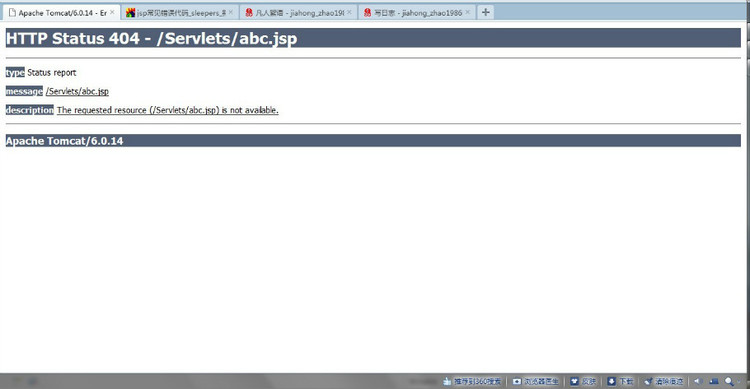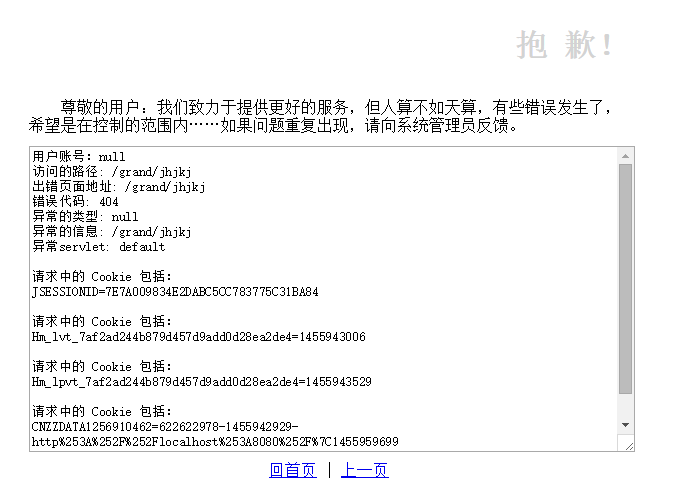Java Web 错误/异常处理页面
2017-04-04 12:13
453 查看
原文地址:点击打开链接
<%@page pageEncoding="UTF-8" isErrorPage="true" import="java.io.*"%>
<%!/**
* 收集错误信息 输出到网页
*
* @param request
* 请求对象
*/
public static OutputStream getError(HttpServletRequest request, Throwable ex) {
try(
OutputStream os = new ByteArrayOutputStream();// 创建一个空的字节流,保存错误信息
PrintStream ps = new PrintStream(os);
){
// 收集错误信息
ps.println("错误代码: " + request.getAttribute("javax.servlet.error.status_code"));
ps.println("异常 Servlet: " + request.getAttribute("javax.servlet.error.servlet_name"));
ps.println("出错页面地址: " + request.getAttribute("javax.servlet.error.request_uri"));
ps.println("访问的路径: " + request.getAttribute("javax.servlet.forward.request_uri"));
ps.println();
for (String key : request.getParameterMap().keySet()) {
ps.println("请求中的 Parameter 包括:");
ps.println(key + "=" + request.getParameter(key));
ps.println();
}
for (Cookie cookie : request.getCookies()) {
ps.println("请求中的 Cookie 包括:");
ps.println(cookie.getName() + "=" + cookie.getValue());
ps.println();
}
// javax.servlet.jspException 等于 JSP 里面的 exception 对象
if (ex != null) {
ps.println("堆栈信息");
ex.printStackTrace(ps);
ps.println();
}
return os;
} catch (IOException e) {
e.printStackTrace();
return null;
}
}
%>
<!DOCTYPE html>
<html>
<head>
<meta charset="utf-8" />
<title>错误页面 code:${requestScope['javax.servlet.error.status_code']}</title>
<style>
body {
max-width: 600px;
min-width: 320px;
margin: 0 auto;
padding-top: 2%;
}
textarea {
width: 100%;
min-height: 300px;
outline:none;
border:1px solid gray;
padding:1%;
}
h1 {
text-align: right;
color: lightgray;
}
div {
margin-top: 1%;
}
</style>
</head>
<body>
<h1>抱 歉……</h1>
<div style="padding:2% 0;text-indent:2em;">尊敬的用户:我们致力于提供更好的服务,但人算不如天算,有些错误发生了,希望是在控制的范围内。如果问题重复出现,请向系统管理员反馈。</div>
<textarea><%
out.print(getError(request, exception));
%></textarea>
<div align="center">
<a href="${pageContext.request.contextPath}">回首页</a> | <a href="javascript:history.go(-1);">上一页</a>
</div>
</body>
</html> ------------------------------------------------------------------------------------------------------------------------------------
发生服务器 500 异常,如果默认方式处理,则是将异常捕获之后跳到 Tomcat 缺省的异常页面,如下图所示。

不论哪个网站都是一样的,所以为了满足自定义的需要,Tomcat 也允许自定义样式的。也就是在 web.xml 文件中配置:
<error-page>
<error-code>500</error-code>
<location>/error.jsp</location>
</error-page>
首先说说自带的逻辑。如果某个 JSP 页面在执行的过程中出现了错误, 那么 JSP 引擎会自动产生一个异常对象,如果这个 JSP 页面指定了另一个 JSP 页面为错误处理程序,那么 JSP 引擎会将这个异常对象放入到 request 对象中,传到错误处理程序中。如果大家有写 Servlet 的印象,这是和那个转向模版 JSP 的 javax.servlet.forward.request_uri 一个思路,保留了原请求的路径而不是 JSP 页面的那个路径。在错误处理程序里,因为 page 编译指令的 isErrorPage
属性的值被设为 true,那么 JSP 引擎会自动声明一个 exception 对象,这个 exception 对象从 request 对象所包含的 HTTP 参数中获得。
request 对象中包含的异常信息非常丰富,如下所示:
你可以用 Java 语句 request.getAttribute("javax.servlet.error.status_code") 获取,也可以在 JSP 页面中通过 EL 表达式来获取,如 ${requestScope["javax.servlet.error.status_code"]}。
这个自定义错误页面虽然简单,JSP 本身也有很好的封装结果,我也看过别人不少的资源,但细究之下也有不少“学问”,于是我想重新再”磨磨这个轮子“——首先 location 是一个 jsp 页面,也可以是 servlet,不过万一 servlet 也有可能启动不起来的话那就使用简单的 JSP 页面就好了。我们通过 JSP 页面定义内部类的方法,达到页面与逻辑的分离(无须编写 servlet)。其余的思路如下:
在 JSP 里面完成 ErrorHandler 类,另有页面调用这个 ErrorHandler 类
不但可以接受 JSP 页面的错误,也可接受 servlet 的控制器传递的错误,并且提取尽量多信息
全部内容先写到内存,然后分别从两个输出流再输出到页面和文件
把错误信息输出到网页的同时,简单加几句话,可以把网页上的信息也写一份到数据库或者文本
可以返回 HTML/JSON/XML
实现代码如下:
<!-- 404 页面不存在错误 -->
<error-page>
<error-code>404</error-code>
<location>/WEB-INF/jsp/common/default/error.jsp</location>
</error-page>
<!-- // -->
<!-- 500 服务器内部错误 -->
<error-page>
<error-code>500</error-code>
<location>/WEB-INF/jsp/common/default/error.jsp</location>
</error-page>
<!-- // --> 我们安排一个默认的页面如下

源码如下:
<%@page pageEncoding="UTF-8" isErrorPage="true"%>
<%@ include file="/WEB-INF/jsp/common/ClassicJSP/util.jsp"%>
<!DOCTYPE html>
<html>
<head>
<title>错误页面</title>
<style>
body {
max-wid
abfd
th: 600px;
min-width: 320px;
margin: 0 auto;
padding-top: 2%;
}
textarea {
width: 100%;
min-height: 300px;
}
h1 {
text-align: right;
color: lightgray;
}
div {
margin-top: 1%;
}
</style>
</head>
<body>
<h1>抱 歉!</h1>
<div style="padding:2% 0;text-indent:2em;">尊敬的用户:我们致力于提供更好的服务,但人算不如天算,有些错误发生了,希望是在控制的范围内……如果问题重复出现,请向系统管理员反馈。</div>
<textarea><%
new ErrorHandler(request, exception, out);
%></textarea>
<div>
<center>
<a href="${pageContext.request.contextPath}">回首页</a> | <a href="javascript:history.go(-1);">上一页</a>
</center>
</div>
</body>
</html>
<%@page pageEncoding="UTF-8" isErrorPage="true" import="java.io.*"%>
<%!/**
* 收集错误信息 输出到网页
*
* @param request
* 请求对象
*/
public static OutputStream getError(HttpServletRequest request, Throwable ex) {
try(
OutputStream os = new ByteArrayOutputStream();// 创建一个空的字节流,保存错误信息
PrintStream ps = new PrintStream(os);
){
// 收集错误信息
ps.println("错误代码: " + request.getAttribute("javax.servlet.error.status_code"));
ps.println("异常 Servlet: " + request.getAttribute("javax.servlet.error.servlet_name"));
ps.println("出错页面地址: " + request.getAttribute("javax.servlet.error.request_uri"));
ps.println("访问的路径: " + request.getAttribute("javax.servlet.forward.request_uri"));
ps.println();
for (String key : request.getParameterMap().keySet()) {
ps.println("请求中的 Parameter 包括:");
ps.println(key + "=" + request.getParameter(key));
ps.println();
}
for (Cookie cookie : request.getCookies()) {
ps.println("请求中的 Cookie 包括:");
ps.println(cookie.getName() + "=" + cookie.getValue());
ps.println();
}
// javax.servlet.jspException 等于 JSP 里面的 exception 对象
if (ex != null) {
ps.println("堆栈信息");
ex.printStackTrace(ps);
ps.println();
}
return os;
} catch (IOException e) {
e.printStackTrace();
return null;
}
}
%>
<!DOCTYPE html>
<html>
<head>
<meta charset="utf-8" />
<title>错误页面 code:${requestScope['javax.servlet.error.status_code']}</title>
<style>
body {
max-width: 600px;
min-width: 320px;
margin: 0 auto;
padding-top: 2%;
}
textarea {
width: 100%;
min-height: 300px;
outline:none;
border:1px solid gray;
padding:1%;
}
h1 {
text-align: right;
color: lightgray;
}
div {
margin-top: 1%;
}
</style>
</head>
<body>
<h1>抱 歉……</h1>
<div style="padding:2% 0;text-indent:2em;">尊敬的用户:我们致力于提供更好的服务,但人算不如天算,有些错误发生了,希望是在控制的范围内。如果问题重复出现,请向系统管理员反馈。</div>
<textarea><%
out.print(getError(request, exception));
%></textarea>
<div align="center">
<a href="${pageContext.request.contextPath}">回首页</a> | <a href="javascript:history.go(-1);">上一页</a>
</div>
</body>
</html> ------------------------------------------------------------------------------------------------------------------------------------
发生服务器 500 异常,如果默认方式处理,则是将异常捕获之后跳到 Tomcat 缺省的异常页面,如下图所示。

不论哪个网站都是一样的,所以为了满足自定义的需要,Tomcat 也允许自定义样式的。也就是在 web.xml 文件中配置:
<error-page>
<error-code>500</error-code>
<location>/error.jsp</location>
</error-page>
首先说说自带的逻辑。如果某个 JSP 页面在执行的过程中出现了错误, 那么 JSP 引擎会自动产生一个异常对象,如果这个 JSP 页面指定了另一个 JSP 页面为错误处理程序,那么 JSP 引擎会将这个异常对象放入到 request 对象中,传到错误处理程序中。如果大家有写 Servlet 的印象,这是和那个转向模版 JSP 的 javax.servlet.forward.request_uri 一个思路,保留了原请求的路径而不是 JSP 页面的那个路径。在错误处理程序里,因为 page 编译指令的 isErrorPage
属性的值被设为 true,那么 JSP 引擎会自动声明一个 exception 对象,这个 exception 对象从 request 对象所包含的 HTTP 参数中获得。
request 对象中包含的异常信息非常丰富,如下所示:
javax.servlet.error.status_code 类型为Integer 错误状态代码 javax.servlet.error.exception_type 类型为Class 异常的类型 javax.servlet.error.message 类型为String 异常的信息 javax.servlet.error.exception 类型为Throwable 异常类 javax.servlet.error.request_uri 类型为String 异常出现的页面 javax.servlet.error.servlet_name 类型为String 异常出现的servlet名
你可以用 Java 语句 request.getAttribute("javax.servlet.error.status_code") 获取,也可以在 JSP 页面中通过 EL 表达式来获取,如 ${requestScope["javax.servlet.error.status_code"]}。
这个自定义错误页面虽然简单,JSP 本身也有很好的封装结果,我也看过别人不少的资源,但细究之下也有不少“学问”,于是我想重新再”磨磨这个轮子“——首先 location 是一个 jsp 页面,也可以是 servlet,不过万一 servlet 也有可能启动不起来的话那就使用简单的 JSP 页面就好了。我们通过 JSP 页面定义内部类的方法,达到页面与逻辑的分离(无须编写 servlet)。其余的思路如下:
在 JSP 里面完成 ErrorHandler 类,另有页面调用这个 ErrorHandler 类
不但可以接受 JSP 页面的错误,也可接受 servlet 的控制器传递的错误,并且提取尽量多信息
全部内容先写到内存,然后分别从两个输出流再输出到页面和文件
把错误信息输出到网页的同时,简单加几句话,可以把网页上的信息也写一份到数据库或者文本
可以返回 HTML/JSON/XML
实现代码如下:
/**
* 异常处理类
*/
class ErrorHandler {
// 全部内容先写到内存,然后分别从两个输出流再输出到页面和文件
private ByteArrayOutputStream byteArrayOutputStream = new ByteArrayOutputStream();
private PrintStream printStream = new PrintStream(byteArrayOutputStream);
/**
* 收集错误信息
* @param request
* @param exception
* @param out
*/
public ErrorHandler(HttpServletRequest request, Throwable exception, JspWriter out) {
setRequest(request);
setException(exception);
if(out != null) {
try {
out.print(byteArrayOutputStream); // 输出到网页
} catch (IOException e) {
e.printStackTrace();
}
}
log(request);
if(byteArrayOutputStream != null)
try {
byteArrayOutputStream.close();
} catch (IOException e) {
e.printStackTrace();
}
if(printStream != null) printStream.close();
}
/**
*
* @param request
*/
private void setRequest(HttpServletRequest request) {
printStream.println();
printStream.println("用户账号:" + request.getSession().getAttribute("userName"));
printStream.println("访问的路径: " + getInfo(request, "javax.servlet.forward.request_uri", String.class));
printStream.println("出错页面地址: " + getInfo(request, "javax.servlet.error.request_uri", String.class));
printStream.println("错误代码: " + getInfo(request, "javax.servlet.error.status_code", int.class));
printStream.println("异常的类型: " + getInfo(request, "javax.servlet.error.exception_type", Class.class));
printStream.println("异常的信息: " + getInfo(request, "javax.servlet.error.message", String.class));
printStream.println("异常servlet: " + getInfo(request, "javax.servlet.error.servlet_name", String.class));
printStream.println();
// 另外两个对象
getInfo(request, "javax.servlet.jspException", Throwable.class);
getInfo(request, "javax.servlet.forward.jspException", Throwable.class);
Map<String, String[]> map = request.getParameterMap();
for (String key : map.keySet()) {
printStream.println("请求中的 Parameter 包括:");
printStream.println(key + "=" + request.getParameter(key));
printStream.println();
}
for (Cookie cookie : request.getCookies()){ // cookie.getValue()
printStream.println("请求中的 Cookie 包括:");
printStream.println(cookie.getName() + "=" + cookie.getValue());
printStream.println();
}
}
/**
*
* @param exception
*/
private void setException(Throwable exception) {
if (exception != null) {
printStream.println("异常信息");
printStream.println(exception.getClass() + " : " + exception.getMessage());
printStream.println();
printStream.println("堆栈信息");
exception.printStackTrace(printStream);
printStream.println();
}
}
/**
*
* @param request
*/
private void log(HttpServletRequest request) {
File dir = new File(request.getSession().getServletContext().getRealPath("/errorLog"));
if (!dir.exists()) {
dir.mkdir();
}
String timeStamp = new java.text.SimpleDateFormat("yyyyMMddhhmmssS").format(new Date());
File file = new File(dir.getAbsolutePath() + File.separatorChar + "error-" + timeStamp + ".txt");
// try(FileOutputStream fileOutputStream = new FileOutputStream(file);
// PrintStream ps = new PrintStream(fileOutputStream)){// 写到文件
// ps.print(byteArrayOutputStream);
// } catch (FileNotFoundException e) {
// e.printStackTrace();
// } catch (IOException e) {
// e.printStackTrace();
// } catch (Exception e){
// e.printStackTrace();
// }
}
/**
*
* @param request
* @param key
* @param type
* @return
*/
@SuppressWarnings("unchecked")
private <T> T getInfo(HttpServletRequest request, String key, Class<T> type){
Object obj = request.getAttribute(key);
return obj == null ? null : (T) obj;
}
}这样就可以完成异常的控制了。下面定义 web.xml,让 tomcat 出错引向我们刚才指定的页面 error.jsp<!-- 404 页面不存在错误 -->
<error-page>
<error-code>404</error-code>
<location>/WEB-INF/jsp/common/default/error.jsp</location>
</error-page>
<!-- // -->
<!-- 500 服务器内部错误 -->
<error-page>
<error-code>500</error-code>
<location>/WEB-INF/jsp/common/default/error.jsp</location>
</error-page>
<!-- // --> 我们安排一个默认的页面如下

源码如下:
<%@page pageEncoding="UTF-8" isErrorPage="true"%>
<%@ include file="/WEB-INF/jsp/common/ClassicJSP/util.jsp"%>
<!DOCTYPE html>
<html>
<head>
<title>错误页面</title>
<style>
body {
max-wid
abfd
th: 600px;
min-width: 320px;
margin: 0 auto;
padding-top: 2%;
}
textarea {
width: 100%;
min-height: 300px;
}
h1 {
text-align: right;
color: lightgray;
}
div {
margin-top: 1%;
}
</style>
</head>
<body>
<h1>抱 歉!</h1>
<div style="padding:2% 0;text-indent:2em;">尊敬的用户:我们致力于提供更好的服务,但人算不如天算,有些错误发生了,希望是在控制的范围内……如果问题重复出现,请向系统管理员反馈。</div>
<textarea><%
new ErrorHandler(request, exception, out);
%></textarea>
<div>
<center>
<a href="${pageContext.request.contextPath}">回首页</a> | <a href="javascript:history.go(-1);">上一页</a>
</center>
</div>
</body>
</html>
相关文章推荐
- Java Web 错误/异常处理页面
- Java Web 错误/异常处理页面
- SpringMVC异常处理以及web错误页面处理
- Java web 项目关于错误页面的处理
- JavaWeb应用中错误和异常处理方法研究
- Windows phone 未处理异常的 错误报告页面
- 使用DundasWebChart展示图表时,出现异常或者跳转到错误页面
- java web中定制应用的错误页面
- java,jsp错误页面在web.xml中的设置
- Java软件低级错误(六):字符串转数字时未进行异常处理
- JAVA年度安全 第二周 WEB.XML中的错误处理
- Asp.Net : 捕捉和记录网站中出现的所有未处理错误,抛出详细的页面来源和访问ip,调用的接口方法及异常实例(记事本日志,系统日志及数据库日志)
- php5与mysql5 web 开发技术详解-16 错误与异常处理
- JavaWeb前台异常处理
- java web项目整体异常处理机制
- java错误异常处理时一定要处理抛出的异常
- 在tomcat的web.xml中声明异常和错误页面
- 用异常来处理错误----第一节 Java异常的概念
- Java读取数据库Blob对象返回到JSP页面和getOutputStream() has already been called for this response异常处理
- Java Web开发初级篇之常见异常处理
